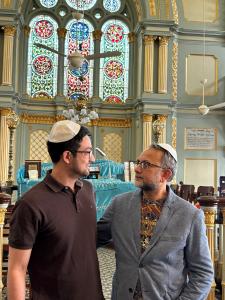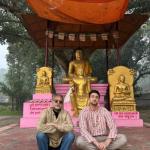
Seeking Religious Harmony in a Divided World
Growing up, we were taught that the fundamental principle of Hinduism is that God is in everyone, that everyone is divine, and that all human beings are fundamentally equal. I have been deeply concerned about the increasing religious polarization in recent years. So, earlier this year, my 28-year-old son Ryan and I embarked on a whirlwind tour of India, the country of our birth. We wanted to experience the country’s incredibly rich variety of religious traditions and witness religious harmony in action.
Our journey was a vibrant tapestry of experiences, leading us to explore various historic sites and religious establishments across the country. The awe-inspiring Ajanta and Ellora caves in Maharashtra left us spellbound, while the spiritual aura of Varanasi and Sarnath in Uttar Pradesh filled us with a profound sense of humility. Sarnath, the site of the Buddha’s first sermon, and Varanasi, the heart of Hinduism, are both revered by Buddhists, Muslims, Christians, Sikhs, and Jains. Our visit to Kolkata, my birthplace and the “city of joy,” was a special homecoming.

Since leaving India in 1984, I have visited numerous times. I also moved back to India from 1993 to 1998, where Ryan was born. I wanted to see what remained of the India of my childhood, a place of unity amid diversity. The spirit of “Unity in Diversity” is a fundamental aspect of Indian identity. The journey also provided an opportunity to connect Ryan to his Indian roots while deepening our own spiritual relationship.
In addition to the spiritual, there was a political dimension. While religious harmony is known to foster social stability, inclusivity, and economic growth, violence based on region—as well as restrictions on religion—is on the rise globally, including in India, according to a report by the Pew Research Center.
Does religious harmony still exist in India?
As one whose life is dedicated to building bridges between people, I had to find out.
Ancient, Majestic, Artistic
Our exploration of India’s diverse faiths began with a visit to the Ellora Caves. These caves, dating from approximately 200 BCE to 1000 CE, consist

of 12 Buddhist caves in the south, 17 Hindu temples in the center, and five Jain temples in the north. The most remarkable of these is Kailasa Temple, also known as Kailasanatha (cave 16), a breathtaking marvel of artistry and spirituality.
The Ajanta Caves, which we visited next, are 29 rock-cut Buddhist cave monuments dating from the second century BCE to about 480 CE in the Aurangabad district of Maharashtra state. Universally regarded as masterpieces of ancient Indian and Buddhist religious art and listed among the UNESCO World Heritage Sites of India, the caves include particularly expressive sculptures and paintings rich in gesture, pose, and form.
Sacred, Timeless, Spiritual
In Varanasi, we immersed ourselves in the vibrant and colorful atmosphere of Hindu temples, including the New Viswanath Temple at Banaras Hindu University (BHU), Devrah Baba Ashram, Dwarkadhish Temple, Sankat Mochan, Sita Ram Temple, and the numerous stairways or ghats along the sacred Ganges, which are used for cleansing and cremation.
As we continued our journey, we embraced the serene ambiance of the Haji Ali Dargah and Mosque in Mumbai and Jama Masjid in Varanasi. I am glad to report that We also experienced the solemn dignity of a synagogue at Knesset Eliyahoo in Mumbai, dating back to 1884, and the peaceful aura of a Sikh Gurudwara—Gurdwara Sri Guru ka Bagh in Varanasi—which commemorates the visit of Guru Nanak, the founder of the Sikh religion, in the sixteenth century.

The profound tranquility of Jain temples, such as the Sri Parswanath Jain Temple in Kolkata and the Jain Temple in Sarnath near Varanasi, left a lasting impact on us. The latter was built in 1824 CE to honor the birthplace of Shreyansanatha, the 11th supreme spiritual teacher or tirthankara. Our exploration also led us to St. Mary’s Church in Varanasi, further testament to the city’s diverse religious landscape.
Peaceful, Enlightening, Historic
One of the most rewarding experiences was our visit to Sarnath, the birthplace of Buddhism. In 528 BCE, Gautama Buddha delivered his first sermon in Sarnath after attaining enlightenment at Bodh Gaya. Sitting near the Bodhi tree in Sarnath (planted in 1931 by Anagarika Dharmapala, founder of the Maha Bodhi Society of India), we felt a deep connection to the spiritual history of this place.
Throughout this journey, I engaged with citizens from all walks of life—friends, fellow airline passengers, Uber and Taxi drivers, hotel staff, tour guides, and many others. While many expressed hope and some voiced frustration, one thing was clear: with few exceptions, they focused on building a prosperous India rather than allowing the nation to be divided.
These conversations reminded me of a vital lesson my mother once taught me: how to transform hope and frustration into a sense of obligation to take action. I have expanded on these lessons in the article.
Our journey to India was enlightening. Within these many sacred spaces, so varied in their expression of devotion, we grasped the uniqueness of each religion’s path to divinity. Yet the sacred spaces all display the common essence of religious experience.

Does religious harmony still exist in India? For my part, I believe the answer is yes, though I realize now that it will always be fragile. Perhaps it always was. A child doesn’t always notice such things.

I now accept that India’s diversity has historically been both a source of rich cultural exchange and tension. In recent years, significant socio-political changes have impacted the dynamics between religious communities. Some argue that instances of heightened religious rhetoric, particularly in politics, have contributed to increased polarization. It is impossible to escape the news, but there are deeper currents of tradition and practice here that serve to counter such polarization, with a staying power measured in millennia.
Harmony, and Hope for the Future
A visit to India, however brief, leaves no one unchanged. My feelings are as complex as the light on the surface of the Ganges.
- As an Indian American, I hope that the country of my birth can continue to model religious harmony in a world struggling with intolerance.
- As a businessman and social entrepreneur, I hope India’s religious diversity can continue to power country’s vast economy, impacting everything from foreign investment, tourism, and workforce productivity to innovation, market expansion, and consumer confidence.
- As a father, I am even more committed to ensuring that Ryan’s generation will inherit a world that celebrates rather than persecutes religious differences.

As he and I shared our impressions, energized with wonder, I was struck anew by the beauty and strength that reside in our diversity. And I returned home to Maryland convinced that we could build a more harmonious and prosperous future together, regardless of our beliefs.
Share your thoughts in the comments—I’d love to hear them!
In my next column, I will share stories why Unity in Diversity is a Bread and Butter Issue for India, followed by my article on how we navigate truth in an age of misinformation.














